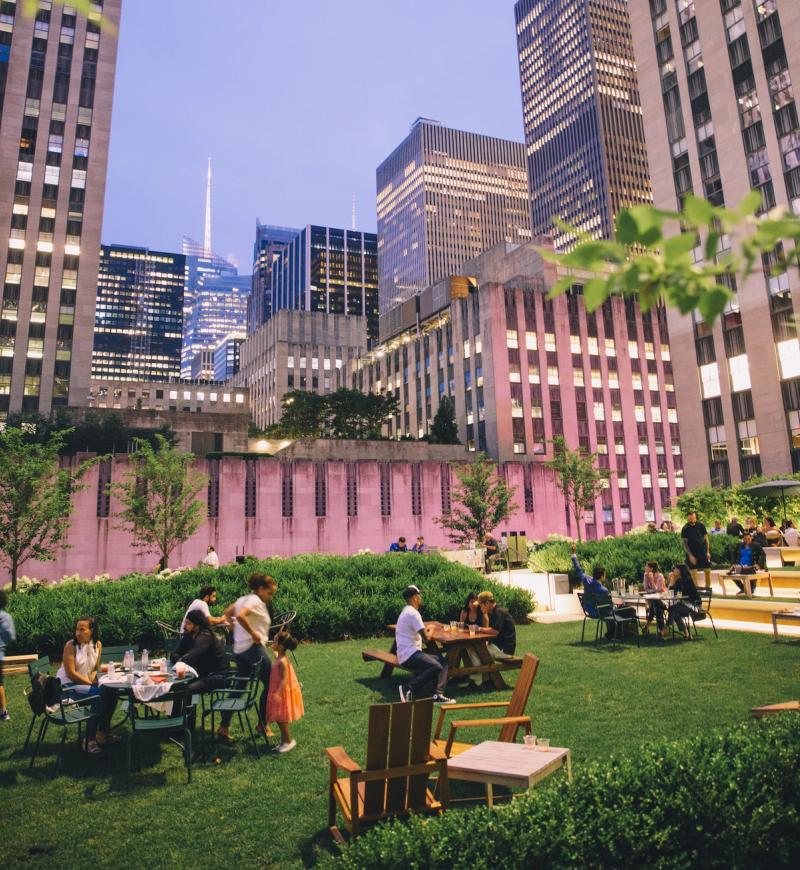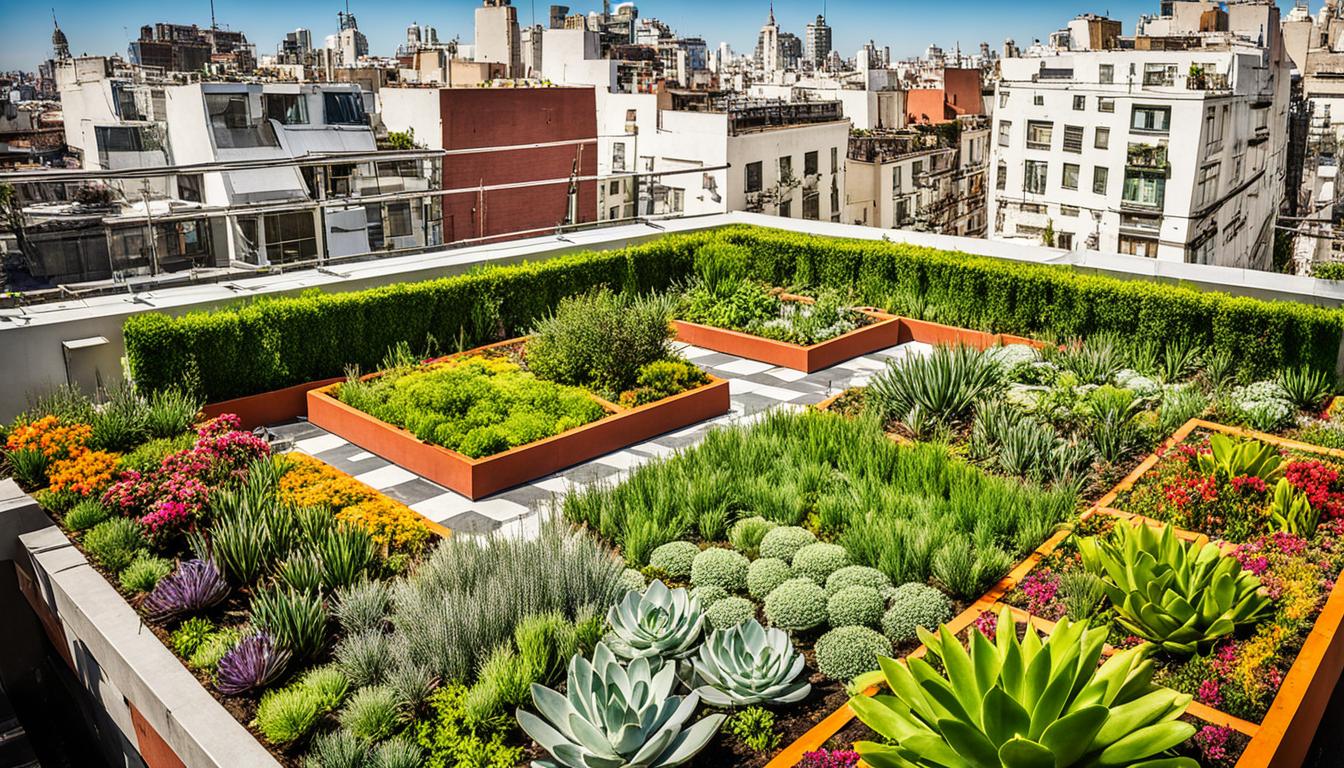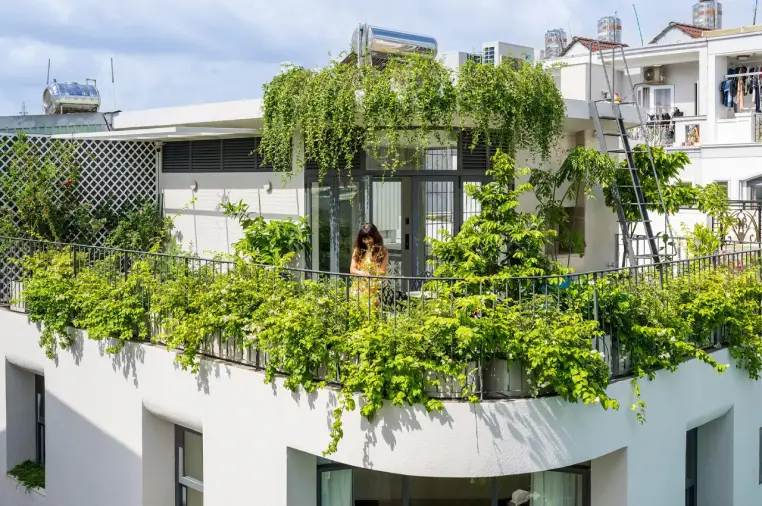Rooftop gardens utilize evapotranspiration and insulation properties to cool buildings. Green roofs absorb less heat, reflecting sun rays to lower urban temperatures.
Exploring the concept of rooftop gardens as an urban cooling solution presents a multifaceted approach to environmental sustainability. As cities grapple with the heat island effect, where built-up areas experience significantly higher temperatures than surrounding rural regions, green roofing emerges as a practical remedy.
Rooftop Garden Cooling Techniques: These living roofs not only enhance aesthetic appeal but serve a critical role in moderating building temperatures. They do so by providing natural insulation and leveraging the cooling effects of plant transpiration. This approach to urban design not only contributes to energy efficiency by reducing the dependency on air conditioning but also fosters biodiversity and improves air quality, making it a strategic inclusion in modern eco-friendly architecture.
Table of Contents

Credit: www.rockefellercenter.com
The Rise Of Rooftop Gardens
Rooftop gardens transform concrete jungles into lush urban oases, combating the intense heat plaguing modern cities. The greenery absorbs sunlight, providing cool shade below. Plants on rooftops use evapotranspiration, releasing moisture into the air, which helps keep the surrounding area noticeably cooler. This natural cooling effect significantly reduces reliance on artificial air conditioning, leading to a greener environment.
These gardens bring about a positive change in the urban environment, leading to improved air quality and increased biodiversity. Apart from cooling, rooftop greenery creates a habitat for birds and insects, making cities livelier and more vibrant. Children and adults alike find these spaces ideal for relaxation and connection with nature.
Getting Started: Basics Of Rooftop Gardening
The first step is to assess the rooftop’s ability to support weight. Safeguarding against potential damage is crucial. A structural analysis determines if extra support is needed.
Choose plants wisely. They must thrive in your specific climate zone. Drought-resistant species are perfect for warm areas. These plants need less water and withstand high temperatures.
Example of an essential considerations table
| Essential Consideration | Details |
|---|---|
| Structural Support | Ensure rooftop can handle garden’s weight. |
| Water Access | Plan for easy watering options. |
| Sun Exposure | Track daily sun path for plant health. |
Design Principles For Cooler Rooftops
Rooftop gardens shape cooler urban spaces by using plants. Plants give shade, which blocks the sun’s heat. A garden must cover most of the roof for the best shade. This way, the building under stays cooler.
Designing with air in mind makes spaces feel fresh. Use tall plants for more wind flow. Open layouts help air move freely. Structures like trellises or pergolas guide a breeze better.
| Feature | Benefit |
|---|---|
| Shade from plants | Reduces direct sunlight |
| Tall plants | Improves airflow |

Credit: vamospanish.com
Evapotranspiration: Nature’s Cooling System
Evapotranspiration is nature’s way to keep things cool. Plants absorb water from the soil and eventually release it through their leaves. This process reduces air temperature around plants. It’s like sweating for plants!
To get the most cooling effect on your rooftop garden, layout is key. Arrange plants to maximize exposure to the air. This lets more water evaporate and cools down your rooftop.
| Step | Action |
|---|---|
| 1 | Choose plants that have high transpiration rates. |
| 2 | Space plants so air flows freely between them. |
| 3 | Maintain a consistent watering schedule to support continuous evapotranspiration. |
Insulation And Cooling: The Green Roof Effect
Rooftop gardens utilize the insulating properties of soil and plants to maintain cooler temperatures. The choice of soil and plants is vital. Opt for soil that holds moisture, like clayey or loamy types, as they’re excellent for insulation. Certain plants, such as succulents and grasses, are perfect for rooftop gardens, as they resist heat and require little water.
Layering techniques are also crucial. A multi-layer structure with a waterproof membrane, insulation layer, and drainage system keeps roots wet and the air cool. This setup creates a natural barrier against heat, contributing to the green roof effect.
Reflective Materials: The Role Of Albedo
High-albedo surfaces are key to cooling rooftops. These surfaces reflect sunlight instead of absorbing it. This means less heat penetrates the building below. White or light-colored materials work best to increase albedo and reduce temperatures.
Many opt to pair high-albedo materials with plants. Together, they enhance cooling effects. Plants provide shade and lower air temperatures through evapotranspiration. It’s a smart way to keep buildings cool without using a lot of energy.
Water Features: An Added Element Of Chill
Rooftop gardens benefit urban areas immensely by reducing heat. A key element in this natural cooling is water features. Fountains, ponds, and waterfalls not only enhance beauty but also contribute to lower temperatures through evaporative cooling.
Fountains circulate water which cools the air. Ponds can act as heat sinks. Waterfalls increase air moisture and cool through evaporation. These features work best when combined with shade-providing plants.
Maintaining Your Cool Roof
Proper irrigation keeps plants healthy, aiding in urban heat reduction. Choosing the right irrigation system saves water and energy.
- Drip irrigation delivers water directly to roots, reducing wastage.
- Automated systems can adjust to weather changes, providing optimal watering.
- Using recycled water for irrigation is both eco-friendly and economical.
Regular weeding and pruning enhance plant growth. Organic mulches keep soil cool and moist.
Case Studies: Successful Urban Rooftop Oases
Urban rooftops have transformed into lush havens in hot climates. The transformation’s key: smart design and evaporative cooling.
In Cairo, Egypt, a building with a garden uses plants that require little water. This garden stays green while using scarce water resources wisely.
Dubai showcases a rooftop with a system that recycles water. The water keeps the garden cool and reduces overall temperature.
| City | Technique | Impact |
|---|---|---|
| Melbourne | White roofing | Reflects sunlight, cools buildings |
| Bangkok | Green layering | Insulates, reduces air con use |
The Future Of Urban Cooling
Rooftop gardens have become a key player in urban temperature control. By using layers of soil and plants, they boost a building’s ability to stay cool. Such gardens act as insulators, reducing the need for air conditioning.
Innovative designs include features like reflective materials and drought-resistant plants. These elements further lower temperatures. The new designs make gardens not only eco-friendly but also cost-effective.
City planners see rooftop gardens as tools for urban policy change. By incorporating them into building codes and zoning laws, they spark community-wide benefits. Such policies aid in creating cooler urban areas, reducing the ‘heat island’ effect.

Credit: www.mansionglobal.com
Frequently Asked Questions Of Rooftop Garden Cooling Techniques
How Do Rooftop Gardens Cool Buildings?
Rooftop gardens cool buildings by providing shade, absorbing heat, and through evapotranspiration, which releases moisture into the air, creating a cooling effect.
What Can I Put On My Roof To Make It Cooler?
Apply reflective paint or install a green roof to reduce rooftop temperature. Use cool roofing materials like solar reflective shingles.
How Do I Reduce The Heat On My Rooftop?
To reduce heat on your rooftop, install reflective materials, add a green roof with plants, use light-colored paint, incorporate shade elements, and invest in rooftop insulation.
What Is The Cool Roof Technique?
The cool roof technique involves using reflective materials on rooftops to reflect more sunlight and absorb less heat, leading to cooler building interiors.
Conclusion
Embracing rooftop gardens is a smart move for urban dwellers. These green oases don’t just beautify; they offer respite from the heat. By harnessing natural processes like evapotranspiration, they keep our spaces cooler. They make the surroundings more comfortable and cut down on cooling costs too.
It’s clear that integrating such eco-friendly solutions into our buildings is a step towards a more sustainable future. By considering these techniques, anyone can transform a bare roof into a cool, leafy retreat. Let’s turn the tide against urban heat – one garden at a time.
